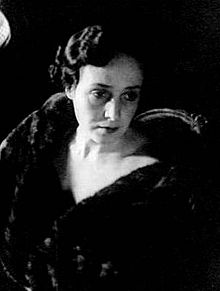Florence Vidor

Florence Vidor (born July 23, 1895 in Houston , Texas , as Florence Cobb , later Florence Arto , † November 3, 1977 in Pacific Palisades , California ) was an American actress of the silent film era .
Life
After some experience on the stage, she married the aspiring director King Vidor in 1915 and went to Hollywood with him a short time later . Florence Vidor was best known for her appearance in A Tale of Two Cities in 1917 and quickly rose to become a popular actress in the Famous-Players-Lasky, who soon merged into Paramount . During that time she was often seen alongside Sessue Hayakawa . However, her strengths were light comedies and elegant melodramas, which she specialized in soon after 1920 and thus finally became a star. From 1919, King Vidor ran her own film studio called Vidor Village for some time , where she shot some films. After her divorce from King Vidor in 1923, she shot with leading comedy directors of her time such as Ernst Lubitsch , Malcolm St. Clair and Harry d'Abbadie d'Arrast . The Grand Duchess and the Waiter with Adolphe Menjou and The Magnificent Flirt , which showed them in 1928 alongside Loretta Young , were among the greatest successes . Her appearance alongside Gary Cooper , who had worked as an extra three years earlier in her film The Enchanted Hill , in the drama Doomsday , also released in 1928, was not quite as successful.
Florence Vidor ended her career after her first and only sound film Chinatown Nights , which showed her as a drug addict of better society, sexually bonded to a gangster played by Wallace Beery . Vidor was so dissatisfied with the changed working conditions that the sound film brought with it that she left the project while filming was still going on. The director William A. Wellman had to shoot the remaining scenes with a body double. The finished film then became a commercial failure.
After the divorce from Vidor, she married the violinist Jascha Heifetz in 1926 , from whom she divorced again in 1946. After her retirement from the acting business, Florence Vidor lived the rest of her life largely withdrawn from the public and took care of the upbringing of her three children.
Filmography (selection)
- 1916: Bill Peter's Kid
- 1917: A Tale of Two Cities
- 1917: The Secret Game
- 1918: Old Wives for New
- 1920: The Jack-Knife Man
- 1921: Hail the Woman
- 1923: The Virginian
- 1923: Alice Adams
- 1924: The Marriage Circle (The Marriage Circle)
- 1925: Are Parents People?
- 1926: The Grand Duchess and the Waiter
- 1926: You Never Know Women
- 1928: Doomsday
- 1928: Your Great Flirt (The Magnificent Flirt)
- 1928: The Patriot (The Patriot)
- 1929: Chinatown Nights
Web links
- Florence Vidor in the Internet Movie Database (English)
- Florence Vidor in the All Movie Guide (English)
- short biography
- short biography
Individual evidence
- ^ Adrian Room: Dictionary of Pseudonyms. 13,000 Assumed Names and Their Origins. 5th edition. McFarland, Jefferson NC et al. 2010, ISBN 978-0-7864-4373-4 , p. 494, ( limited preview in Google book search).
- ↑ Florence Vidor | Biography, Movie Highlights and Photos. Retrieved March 11, 2020 (American English).
- ^ Scott Eyman : The Speed of Sound: Hollywood and the Talkie Revolution 1926-1930 . New York: Simon and Schuster, 1997.
- ↑ Florence Vidor | Biography, Movie Highlights and Photos. Retrieved March 11, 2020 (American English).
| personal data | |
|---|---|
| SURNAME | Vidor, Florence |
| ALTERNATIVE NAMES | Cobb, Florence (maiden name); Arto, Florence |
| BRIEF DESCRIPTION | American actress of the silent film era |
| DATE OF BIRTH | July 23, 1895 |
| PLACE OF BIRTH | Houston , Texas , United States |
| DATE OF DEATH | 3rd November 1977 |
| Place of death | Pacific Palisades , California , United States |
